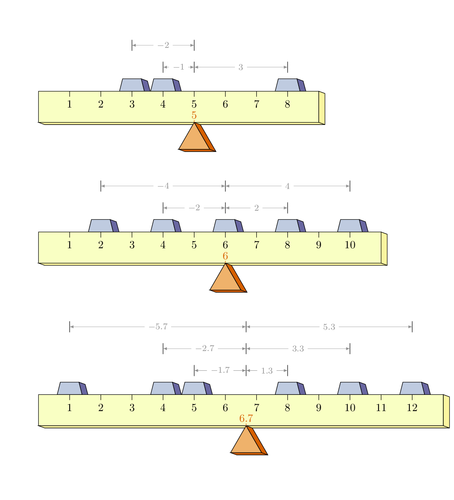Given a list of n positive integers the Balance environment produces an illustration of the arithmetic mean of the integers as the center of mass of a system formed by n objects (of equal mass) placed along a solid rod at the positions specified by the list of integers.
This example was created by Gonzalo Medina (http://tex.stackexchange.com/users/3954/gonzalo-medina) answering a question of MYaseen208 on TeX.SE (http://tex.stackexchange.com/q/176466/3954).

Edit and compile if you like:
\documentclass{article}
\usepackage{tikz}
\usepackage[active,tightpage]{preview}
\PreviewEnvironment{flushleft}
\setlength\PreviewBorder{35pt}%
% colors for the ruled rectangle
\definecolor{color1}{RGB}{249,255,195}
\definecolor{color2}{RGB}{251,245,160}
% colors for the fulcrum
\definecolor{color3}{RGB}{239,178,107}
\definecolor{color4}{RGB}{214,96,0}
% colors for the weights
\definecolor{color5}{RGB}{191,203,224}
\definecolor{color6}{RGB}{105,103,161}
% A pic path for the weights
\tikzset{
Peso/.pic={
\coordinate (wll) at (-0.4cm,0);
\coordinate (wlr) at (0.4cm,0);
\coordinate (wul) at (-0.3cm,0.4cm);
\coordinate (wur) at (0.3cm,0.4cm);
\draw[fill=color5]
(wll) -- (wlr) -- (wur) -- (wul) -- cycle;
\draw[fill=color6]
(wur) --
++(-\Angle:6pt) --
++(-75:0.4cm) --
(wlr) --
cycle;
}
}
% counters to store the number of weights and the sum of
% the given integers
\newcounter{Number}
\newcounter{Suma}
% to perform a scaling along the x-axis (1cm=no scaling)
\newlength\XFactor
\setlength\XFactor{1cm}
% the height of the rectangle
\def\RectHt{1cm}
% the angle for the 3D effect
\def\Angle{20}
% lengths controlling the help lines separation
\def\Corr{1pt}
\def\Gap{6pt}
% the main environment
\newenvironment{Balance}[1]
{%
\medskip\par\noindent
\setcounter{Number}{0}%
\setcounter{Suma}{0}%
\begin{tikzpicture}[x=\XFactor]
\foreach \Valor in {#1}
{
\pic at (\Valor,\RectHt) {Peso};
\stepcounter{Number}%
\addtocounter{Suma}{\Valor}
\xdef\Steps{\Valor}
}
\def\RectWd{\numexpr\Steps+1\relax*\XFactor}%
\pgfmathsetmacro{\FulcrumCoord}{\theSuma/\theNumber}
% The ruled rectangle
\coordinate (ll) at (0,0);%\node at ([xshift=-10pt]ll) {\FulcrumCoord};
\coordinate (ur) at (\RectWd,\RectHt);
\draw[fill=color1]
(ll) rectangle (ur);
\draw[fill=color2]
(ur) --
++(-\Angle:6pt) --
++(0,-\RectHt) --
++(-\RectWd,0) --
(ll) --
++(\RectWd,0) --
cycle;
\foreach \Valor in {1,...,\Steps}
\draw (\Valor,1) -- ++(0pt,-5pt) node[below] {\Valor};
\draw (\RectWd,0) -- ++(-\Angle:6pt);
% The fulcrum
\draw[fill=color3]
(\FulcrumCoord,0) --
++(240:1) --
++(1,0) coordinate (aux) --
cycle;
\draw[fill=color4]
(\FulcrumCoord,0) --
++(-\Angle:6pt) --
++(-60:1) --
++(-1,0) --
++(180-\Angle:6pt) --
++(1,0) --
cycle;
\draw (aux) -- ++(-\Angle:6pt);
\coordinate (cotaFulc)
at (\FulcrumCoord,\RectHt);
\draw[color4]
(\FulcrumCoord,0) --
++(0,2pt)
node[above=-2pt] {\pgfmathprintnumber[precision=1]{\FulcrumCoord}};
}
{\end{tikzpicture}\medskip\par\noindent}
% the command to draw help lines
\newcommand\Cotas[2][1]{
\draw
(\FulcrumCoord,\RectHt+#1\Corr+\number\numexpr#1-1\relax\Gap) --
++(0,10pt);
\foreach \Valor in {#2}
{
\draw
(\Valor,\RectHt+#1\Corr+\number\numexpr#1-1\relax\Gap) --
coordinate (cota\Valor)
++(0,10pt);
\draw[<->,>=latex,help lines]
(cotaFulc|-cota\Valor) --
node[fill=white] {\footnotesize$\pgfmathparse{\Valor-\FulcrumCoord}%
\pgfmathprintnumber[precision=1]{\pgfmathresult}$}
(cota\Valor);
}
}
\begin{document}
\begin{flushleft}
\begin{Balance}{3,4,8}
\Cotas{4,8}
\Cotas[2]{3}
\end{Balance}
\begin{Balance}{2,4,6,8,10}
\Cotas{4,8}
\Cotas[2]{2,10}
\end{Balance}
\begin{Balance}{1,4,5,8,10,12}
\Cotas{5,8}
\Cotas[2]{4,10}
\Cotas[3]{1,12}
\end{Balance}
\end{flushleft}
\end{document}Click to download: balance.tex • balance.pdf
Open in Overleaf: balance.tex


